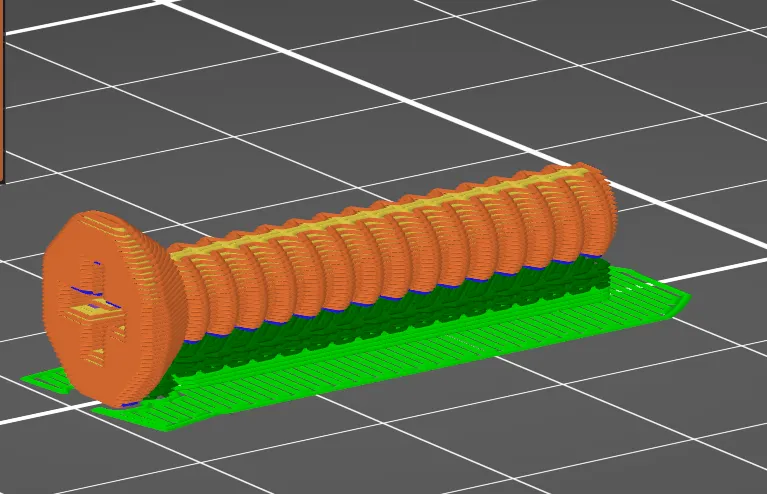Bed levelling or in true terms bed traming is adjustment to how parallel the hot end nozzle travels across the surface of the print bed.
With frustration and perceverence, I was able to achieve perfect first layer adhesion, reduced z-wobble and good prints.
I would like to share a simple concept and process on how I achieved true traming without continuous adjustments and I only redo this process only if something major disturbs the printer and bed. This is the manual process which I use to tram both my Ender 3 V2 Neo and Neptune 4 Plus. Refinement and fine tuning can be achieved via software and manual spacing.
I am not an expert, but only sharing my observation and results from learning from my mistakes.
The picture above represents a cross-section of the nozzle and print bed assembly with a blue line representing true levelling (traming).
The print bed is made of an alluminum plate. Due to thermal expansion and contraction, metal will become distorted in it's natural state if without reinforcement. When heated, metal expands and when cooled metal contracts.
Before attempting this process, print and install appropriate adjustment screw locks for your specific printer and that you have calibrated E-Step of the extruder and Temperature. This is the minimum to satisfy your level but not the complete calibration process of your printer.
Levelling process and concept
The first picture shows, the bed is bowed downwards, and all the adjustment screws is all the way down.
All of my 3D printers as they come out of the box, the bed has a downward bow. You can measure this from the middle of your X-axis gangtree if its square down to the bed and repeat from the X-axis gangree to the edge of the bed.
The second picture show, as you wind all the adjustment screws all the way up, force is applied to the edges of the print bed making the bed bow upwards. You can verify this by measuring from the X-axis gangtree as described previously.
*** Take note, the first two pictures is the bed 'Unheated'.
When I'm traming, I do the usual paper (feeler gauge 0.05mm) technique to get my Z-offset and evenly adjusting the screws between the nozzle (unheated) to tram the print bed before auto-levelling.
From the third picture, the yellow line represents my perceived traming - traming the print bed in relation to true level.
Once I auto-level and the bed heats up, due to thermal expansion, the bed bows upwards. The problem here, is that the Z-offset will compensate for any distortion of the bed, but when the nozzle prints either side of the bow, you may think your layer is level, in fact the first layer is barely adhering, due to the Z-offet has it's level computed from the bow when auto-leveling.
*** From my experience, this is why I get problems with layer adhesion.
The fourth picture, I adjust my adjustment screws, so my print bed is just a tad below actual level. As you can see the yellow line has a downwards bow. The reason for this, is to compensate for the bed bowing up to achieve true level when the bed becomes 'heated' during auto-level.
*** I have reduced Z-wobble because how this process helped to damped or reduced the Z-axis movement and have better first layer adhesion.
Check for level and first layer quality
*** What you are doing is setting the correct filament extrusion for the first layer. What you want to achieve is consistent layer that has no over or under extrusion.
*** For under extrusion, the filament layer is apart from each other and eventually, the further you adjust the Z-offset away from the bed, the filament will not adhere and detatch itself from the bed.
*** For over extrusion, the filament will bulge around the nozzle, causing raises of streaks above the surface of the first layer. The closer you adjust the Z-offset towards the bed, more filament will streak and eventually no filament will be extruded.
-
Once you have justified the correct Z-offset, let it finish the print.
-
Print another layer without adjusting the Z-offset.
*** If the result of your first layer test is consistent in the layer without under or overextrusion symtoms, your print bed is level.
*** If you find raise streaks on areas of the print, that part of the print bed is high. If you find blistering raises, that part of the print bed is low.
- Adjust as per levelling process above until you achieve a nice first layer.
You can make refinements to the actual bed before auto-leveling by adding alluminum tape or something thin enought to act as spacers if your bed is badly distorted. If you cannot achieve your desired first layer after many adjustments, then there is a probability that part of the bed is distorted enough you need spacers.
To fine tune after auto-leveling you can use bed meshing software like klipper if you have it on your printer or have modified it have these priviledges. I only use this method to really hone it to get a perfect print. But in general manual levelling will be suffice.
Please let me know if this has helped







